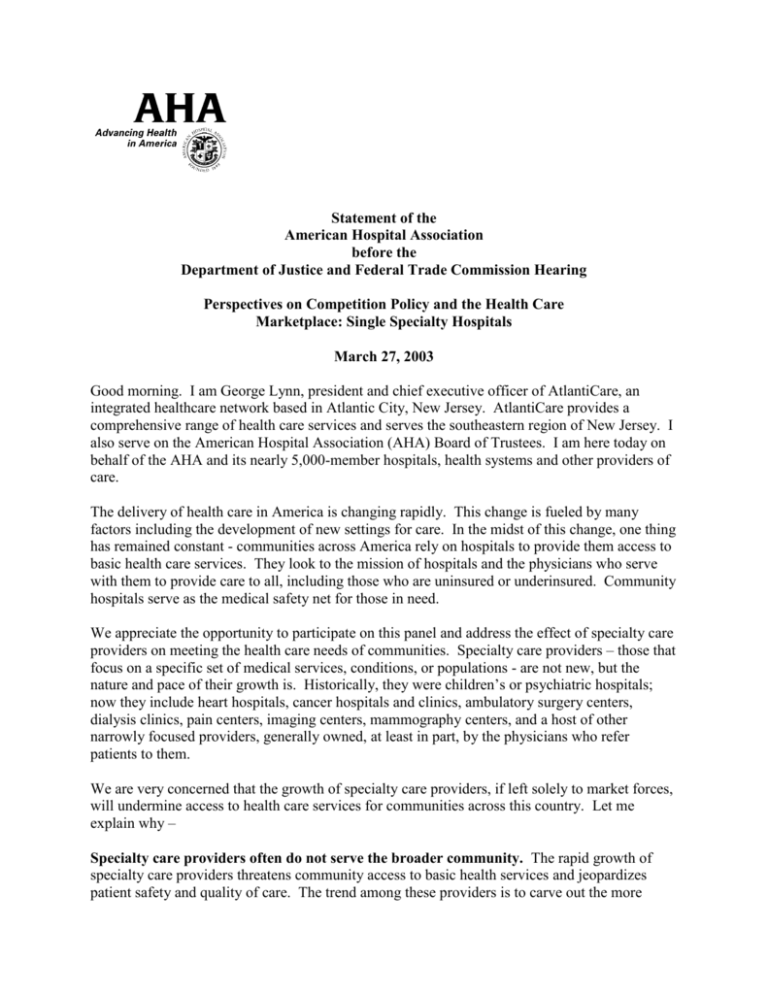March 27, 2003 - American Hospital Association
advertisement

Statement of the American Hospital Association before the Department of Justice and Federal Trade Commission Hearing Perspectives on Competition Policy and the Health Care Marketplace: Single Specialty Hospitals March 27, 2003 Good morning. I am George Lynn, president and chief executive officer of AtlantiCare, an integrated healthcare network based in Atlantic City, New Jersey. AtlantiCare provides a comprehensive range of health care services and serves the southeastern region of New Jersey. I also serve on the American Hospital Association (AHA) Board of Trustees. I am here today on behalf of the AHA and its nearly 5,000-member hospitals, health systems and other providers of care. The delivery of health care in America is changing rapidly. This change is fueled by many factors including the development of new settings for care. In the midst of this change, one thing has remained constant - communities across America rely on hospitals to provide them access to basic health care services. They look to the mission of hospitals and the physicians who serve with them to provide care to all, including those who are uninsured or underinsured. Community hospitals serve as the medical safety net for those in need. We appreciate the opportunity to participate on this panel and address the effect of specialty care providers on meeting the health care needs of communities. Specialty care providers – those that focus on a specific set of medical services, conditions, or populations - are not new, but the nature and pace of their growth is. Historically, they were children’s or psychiatric hospitals; now they include heart hospitals, cancer hospitals and clinics, ambulatory surgery centers, dialysis clinics, pain centers, imaging centers, mammography centers, and a host of other narrowly focused providers, generally owned, at least in part, by the physicians who refer patients to them. We are very concerned that the growth of specialty care providers, if left solely to market forces, will undermine access to health care services for communities across this country. Let me explain why – Specialty care providers often do not serve the broader community. The rapid growth of specialty care providers threatens community access to basic health services and jeopardizes patient safety and quality of care. The trend among these providers is to carve out the more profitable services and to serve the more profitable patients. They leave the community hospital to provide unprofitable services, such as trauma, and to care for all, regardless of their ability to pay. Specialty care providers have little or no obligations under the Emergency Medical Treatment and Labor Act (EMTALA), either because they operate on an ambulatory basis or because they do not have emergency departments (ED). Specialty care providers rely on the ED capacity of local community hospitals. Many specialty care providers do not participate in Medicare and/or Medicaid or limit their participation when they do, and many provide little uncompensated care. These business decisions allow some specialty care providers to produce services less expensively, while often being paid the same or more than community hospitals that carry the social obligations to provide care to all 24/7, 365 days a year. Specialty providers are undercutting the ability of community hospitals to meet the needs of the broader community. As profitable services are drawn away from general community hospitals, it becomes more difficult to support services needed by the community that are unprofitable. Trauma centers, burn units, and EDs are not self-supporting. Caring for the uninsured, Medicaid patients and others who have limited coverage can only be accomplished if the hospital can rely on revenues from profitable services. If the profitable services and more profitable patients are removed from the community hospital, its ability to continue meeting the needs of the entire community deteriorates. The result: the community loses access to specific services or ultimately to all the hospital’s services as the general hospital closes. Communities are also losing access to specialty physicians because of the growth of specialty providers. The consequences for emergency patients can be life threatening. Many communities are already experiencing this problem as hospital EDs go on diversion for all or certain types of cases. A primary reason: lack of specialty physicians willing to serve on-call and treat patients in need. At the same time specialty providers are drawing profitable services and specialty physicians away from the community hospital, they expect those same hospitals to be their back-up. Consider the safety of a patient admitted to a specialty hospital for a routine surgical procedure, who then develops complications beyond the capacity of that specialty. This surgical patient has to be transferred to a general acute care hospital for needed care. Or consider the nearby resident out for a jog, who experiences chest pain outside a specialty hospital, goes inside to seek assistance, and is told to call 911. Specialty providers are increasingly owned by the same physicians who make decisions about when and where patients should receive care. Specialty physicians are making decisions about care for their patients that will also have an effect on the physician's personal financial interest. Even in a competitive environment, caring for sick people transcends the simple buyer/seller relationship. Patients need to be able to trust that decisions about their care will be made on the basis of what is in the best interest of the patient, not the provider. Left to market forces alone, the incentives in a competitive market may lead some providers to make business decisions that raise issues for the patients and communities they serve. 2 In closing, communities will not be well served if the growth of specialty providers is viewed solely from the perspective of bringing more entrants into the marketplace. Their growth must also be looked at from the perspective of meeting the health care needs of a community. In that context, these providers do not add a satisfactory alternative. Instead they withdraw resources for a select, desirable, population and leave to others the responsibility for meeting the needs of the entire community, while compromising their ability to do so. The local hospital is part of the essential fabric of a community. For the antitrust agencies to truly assess the effect of specialty care providers, they need to take into account their effect on the medical safety net for a community and whether the needs of the entire community are served by their presence and growth. Thank you. 3




